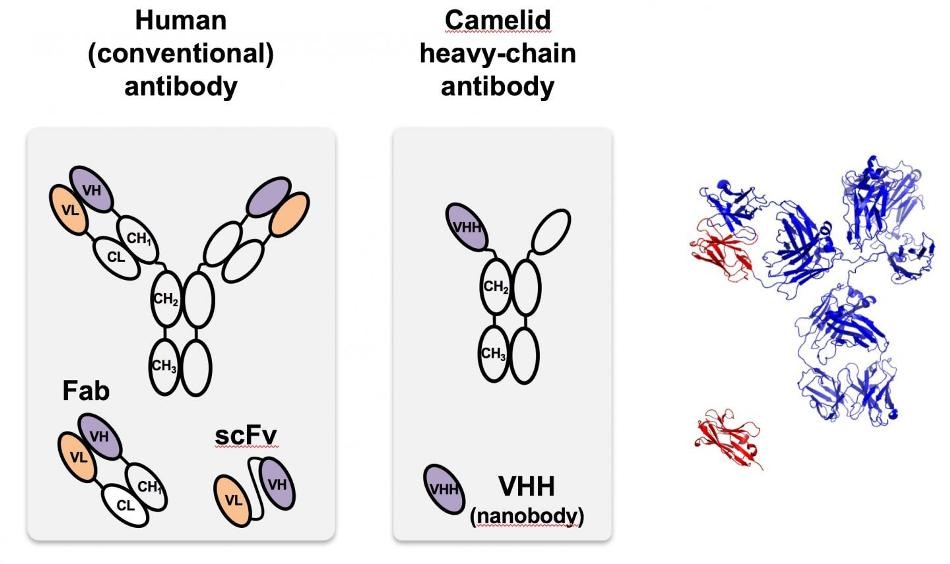Oct 31 2017
According to Rice University researchers, a nanoscale antibody first found in camels integrated with a protein-degrading molecule is an effective new system to regulate protein levels in cells. The method could help major research into cellular dynamics as well as the design of artificial gene circuits.
 The camelid nanobody (center), first identified in camels, is a heavy-chain antibody that is much smaller and easier to program than antibodies found in most organisms, including humans, like that at left. At right, the monomeric camelid (red) is compared with the structure of the full-sized human antibody. VHH is a nanobody designed to target green fluorescent proteins used in proof-of-principle tests at Rice. Click on the image for a larger version. (Courtesy of the Segatori Research Group)
The camelid nanobody (center), first identified in camels, is a heavy-chain antibody that is much smaller and easier to program than antibodies found in most organisms, including humans, like that at left. At right, the monomeric camelid (red) is compared with the structure of the full-sized human antibody. VHH is a nanobody designed to target green fluorescent proteins used in proof-of-principle tests at Rice. Click on the image for a larger version. (Courtesy of the Segatori Research Group)
Rice chemical and biomolecular engineer Laura Segatori, former graduate student Wenting Zhao and former undergraduate Lara Pferdehirt invented a bi-functional recognition system they refer to as NanoDeg. It allows them to target particular proteins in a cell and stringently regulate their degradation.
The plug-and-play system will allow synthetic biologists to examine the function of a particular protein within the cellular environments by evaluating how the protein expression level impacts the life of a cell, Segatori said.
The research has been published in the American Chemical Society journal ACS Synthetic Biology.
NanoDeg speeds up proteolysis — the enzymatic breakdown of proteins — to manipulate the levels of targeted proteins after translation.
One function comes from the single-chain antibody from camelids, which can be tailored to target particular proteins. When the antibodies were found in camels (and later sharks), scientists quickly identified their unique properties, including their small size, high solubility and ability to distinguish targets that are concealed or in intermediate states. They are a lot smaller than the antibodies found naturally in humans and a majority of other organisms but can be easily made and altered in bacteria and other cells.
The other function depends on degrons, short sequences in proteins that are accountable for controlling the rate of a protein’s degradation. These can also be modified to tune the depletion of a target protein to the preferred levels.
When integrated as NanoDegs, they become a robust, universal platform for controlling cellular protein levels, Segatori said.
Essentially, it allows us to control the specific amount of proteins in cells, we can tailor it to target any protein in a cell, and once the degron-tagged nanobody binds to that partner, the whole complex is degraded.
Laura Segatori, Rice chemical and biomolecular engineer
“The advantage of this system is that it targets expression at the protein level,” Segatori said. “Typically, when people want to modulate the amount of proteins in cells, they act at the DNA or RNA — the genetic — level. But by acting at the protein level, we can target different post-regulation modifications, and much more importantly, we have much more control over the rate and extent of depletion of the protein.”
As a proof of principle, the team designed an artificial gene circuit that expressed both green fluorescent protein (GFP), which the researchers use to report on cellular processes, and a NanoDeg that targets it. “We used GFP because it is a commonly used reporter and fluorescence is easy to measure,” Segatori said. “When the nanobody recognizes GFP, the whole complex is taken for degradation.”
It will be also beneficial to those who want cleaner information regarding the funtions of proteins in cells.
“Say you design a genetic circuit in which GFP expression is activated when the cell is under stress, like nutrient starvation or heat, for example,” Segatori said. “When the cell is exposed to the stimulus, GFP is expressed and you can detect an increase in cell fluorescence.
But when you take away the stimulus, the decay of the signal doesn’t necessarily reflect the decay of the stimulus; it reflects the stability of the GFP reporter, what we’ve done is create a gene circuit in which GFP expression is activated under stimulus, but when the stimulus is turned off, the NanoDeg degrades GFP very rapidly. That increases the sensitivity and dynamic resolution of a synthetic gene circuit.
Laura Segatori, Rice chemical and biomolecular engineer
Zhao, first author of the paper, is currently a postdoctoral researcher in systems biology at Columbia University Medical Center. Co-author Pferdehirt is at present a graduate student at Washington University. Segatori is an associate professor of chemical and biomolecular engineering, of bioengineering and of biochemistry and cell biology.
This research was supported by the National Science Foundation, the Welch Foundation and the Kleberg Foundation.